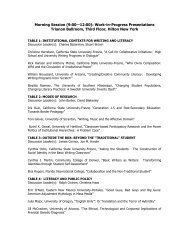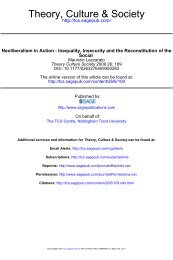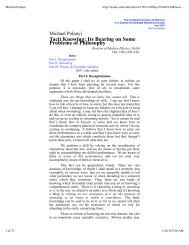PUBLIC OPINION by WALTER LIPPMANN TO FAYE LIPPMANN ...
PUBLIC OPINION by WALTER LIPPMANN TO FAYE LIPPMANN ...
PUBLIC OPINION by WALTER LIPPMANN TO FAYE LIPPMANN ...
You also want an ePaper? Increase the reach of your titles
YUMPU automatically turns print PDFs into web optimized ePapers that Google loves.
CHAPTER XV<br />
LEADERS AND THE RANK AND FILE<br />
I<br />
BECAUSE of their transcendent practical importance, no successful<br />
leader has ever been too busy to cultivate the symbols which organize<br />
his following. What privileges do within the hierarchy, symbols do for<br />
the rank and file. They conserve unity. From the totem pole to the<br />
national flag, from the wooden idol to God the Invisible King, from<br />
the magic word to some diluted version of Adam Smith or Bentham,<br />
symbols have been cherished <strong>by</strong> leaders, many of whom were themselves<br />
unbelievers, because they were focal points where differences merged.<br />
The detached observer may scorn the "star-spangled" ritual which<br />
hedges the symbol, perhaps as much as the king who told himself that<br />
Paris was worth a few masses. But the leader knows <strong>by</strong> experience that<br />
only when symbols have done their work is there a handle he can use to<br />
move a crowd. In the symbol emotion is discharged at a common target,<br />
and the idiosyncrasy of real ideas blotted out. No wonder he hates<br />
what he calls destructive criticism, sometimes called <strong>by</strong> free spirits<br />
the elimination of buncombe. "Above all things," says Bagehot, "our<br />
royalty is to be reverenced, and if you begin to poke about it you<br />
cannot reverence it." [Footnote: _The English Constitution,_ p.<br />
127. D. Appleton & Company, 1914.] For poking about with clear<br />
definitions and candid statements serves all high purposes known to<br />
man, except the easy conservation of a common will. Poking about, as<br />
every responsible leader suspects, tends to break the transference of<br />
emotion from the individual mind to the institutional symbol. And the<br />
first result of that is, as he rightly says, a chaos of individualism<br />
and warring sects. The disintegration of a symbol, like Holy Russia,<br />
or the Iron Diaz, is always the beginning of a long upheaval.<br />
These great symbols possess <strong>by</strong> transference all the minute and<br />
detailed loyalties of an ancient and stereotyped society. They evoke<br />
the feeling that each individual has for the landscape, the furniture,<br />
the faces, the memories that are his first, and in a static society,<br />
his only reality. That core of images and devotions without which he<br />
is unthinkable to himself, is nationality. The great symbols take up<br />
these devotions, and can arouse them without calling forth the<br />
primitive images. The lesser symbols of public debate, the more casual<br />
chatter of politics, are always referred back to these proto-symbols,<br />
and if possible associated with them. The question of a proper fare on<br />
a municipal subway is symbolized as an issue between the People and<br />
the Interests, and then the People is inserted in the symbol American,<br />
so that finally in the heat of a campaign, an eight cent fare becomes<br />
unAmerican. The Revolutionary fathers died to prevent it. Lincoln





